![]()
![]()
![]()
Use LEFT and RIGHT arrow keys to navigate between flashcards;
Use UP and DOWN arrow keys to flip the card;
H to show hint;
A reads text to speech;
29 Cards in this Set
- Front
- Back
- 3rd side (hint)

What portion of the Internal Capsule is indicated by the purple arrow?
|

The Anterior Limb
|
|
|

What portion of the Internal Capsule is indicated by the purple arrow?
|

The Genu.
|
|
|
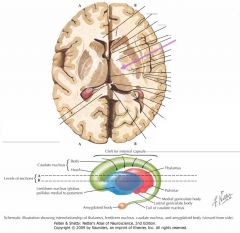
What portion of the Internal Capsule is indicated by the purple arrow?
|

The Posterior Limb,
between the Globus Pallidus and the Thalamus. |
|
|

What portion of the Internal Capsule is indicated by the purple arrow?
What types of fibres pass through it? |

The Retrolenticular Limb.
The Optic Radiations from the Lateral Geniculate Bodies pass through it on their way to the Occipital Lobe. |
|
|
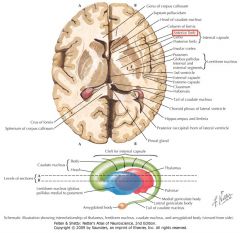
What fibres pass through the Anterior Limb of the Internal Capsule?
|

It includes:
1) Frontopontine Fibres, 2) Anterior Thalamic Radiations (Medial and anterior thalamic projections to the frontal and cingulate cortex) and, 3) Descending fibres from the Frontal Eye Fields. |
|
|

What fibres pass through the Genu of the Internal Capsule?
|

Corticonuclear Fibres (projection fibres), projecting to the motor nuclei of the cranial nerves.
|
|
|
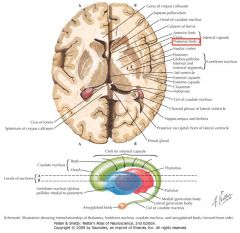
What fibres pass through the Posterior Limb of the Internal Capsule?
|

It contains:
1) The Superior Thalamic Radiations (VA, VL, and VP projections to motor and sensory cortices) 2) Corticospinal projections, 3) Others. (Corticotegmental [yellow box], Parietopontine, and Pallidothalamic* fibres) |
*Connecting the Globus Pallidus Medius to the Thalamus.
|
|

What fibres pass through the Posterior Limb of the Internal Capsule?
|
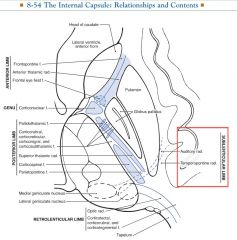
It contains:
1) The Superior Thalamic Radiations (VA, VL, and VP projections to motor and sensory cortices) 2) Corticospinal projections, 3) Others. (Corticotegmental [yellow box], Parietopontine, and Pallidothalamic* fibres) |
*Connecting the Globus Pallidus Medius to the Thalamus.
|
|

What fibres pass through the Posterior Limb of the Internal Capsule?
|

It contains:
1) The Superior Thalamic Radiations (VA, VL, and VP projections to motor and sensory cortices) 2) Corticospinal projections, 3) Others. (Corticotegmental [yellow box], Parietopontine, and Pallidothalamic* fibres) |
*Connecting the Globus Pallidus Medius to the Thalamus.
|
|

What portion of the Internal Capsule is indicated by the purple arrow?
What fibres does it carry? |

The Sublenticular Limb. It carries:
1) Auditory Radiations (from the MGN to the Temporal Lobe) and, 2) Temporopontine Radiations. |
|
|

What types of fibres are carried by the Internal Capsule?
|

Projection Fibres.
(as opposed to Commissural Fibres, and Association Fibres) |
|
|
|
How can you distinguish the External and Extreme Capsules?
What fibres do they carry? |

The External Capsule is located between the Putamen and the Claustrum, and the Extreme Capsule is between the Claustrum and the Insular Cortex.
Not sure: Some sources describe both as having Association Fibres (between two areas of the cortex), and others suggesting that the External Capsule includes Projection Fibres to the Putamen. |
|
|
|
Anatomically, what's the difference between Ganglia, Nuclei, and Cortex?
|

Ganglia: Neuronal cell bodies and dendrites (grey matter) in the PNS.
Nuclei: Grey matter in the CNS that is surrounded by white matter. (blue arrows) Cortex: Grey matter in the outer layer of the CNS. (red arrow) |
|
|

What structure is indicated by the purple arrow?
What is its overall shape? |

The Head and Tail of the Caudate Nucleus.
It is a C-shaped structure that wraps around the Lentiform Nucleus and tapers to its tail towards the Amygdala. |
|
|

What do the Caudate and the Putamen form together?
|
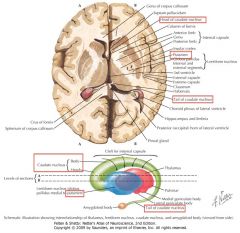
The "Neostriatum," (Striatum)
as opposed to the "Paleostriatum" (Pallidum), which refers to the Globus Pallidus. |
|
|

What structure is indicated by the red arrow?
What does it form with the Globus Pallidus? With the Claustrum? With the Caudate Nucleus? |

The Putamen.
With the Globus, it forms the Lentiform Nucleus. With the Caudate, it forms the Neostriatum. All three form the Corpus Striatum. The Claustrum is on its own. It has no special friends. |
|
|

What grey matter is indicated by the red arrow?
What is it bordered by? |

The Claustrum.
Bordered medially by the External Capsule, and laterally by the Extreme Capsule. We don't know its function, but it is extensively connected to the cerebral cortex. |
|
|

What are the components of the (modern) Basal Ganglia?
They've all got bits showing in this image. |

1. The Caudate Nucleus,
2. Putamen, 3. Globus Pallidus, 4. Subthalamic Nucleus, and 5. Substantia Nigra. Note: does not include the Claustrum. It has no friends. |
|
|

Which portion of the Lateral Ventricle is indicated by the white arrow?
|

The Anterior Horn,
which extends into the Frontal Lobe. |
|
|

Which portion of the Lateral Ventricle is indicated by the white arrow?
|

The Body.
|
|
|

Which portion of the Lateral Ventricle is indicated by the white arrow?
|

The Inferior Horn,
which extends into the Temporal Lobe. |
|
|

Which portion of the Lateral Ventricle is indicated by the white arrow?
|

The Posterior Horn,
which extends into the Occipital Lobe. |
|
|

Which portion of the Lateral Ventricle is indicated by the white arrow?
|

The Trigone, where the Body, Inferior Horn, and Posterior Horn meet, and there's a little triangle.
|
|
|

What ventricle is indicated by the white arrow?
|

The Third Ventricle.
|
|
|

What space is indicated by the white arrow?
What ventricles does it connect? |

The Interventricular Foramen (of Munro).
It connects a Lateral Ventricle to the Third Ventricle, and there's one on each side. |
|
|
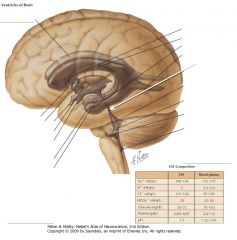
What space is indicated by the white arrow?
What ventricles does it connect? |

The Cerebral Aqueduct (of Sylvius)
It connects the Third and Fourth Ventricles. |
|
|

Which ventricle is indicated by the white arrow?
|

The Fourth Ventricle.
|
|
|

How is the Fourth Ventricle continuous with the Subarachnoid Space?
|

Through the two lateral Foramina of Luschka, and the medial Foramen of Magendi.
|
|
|

What fills the Ventricles of the Brain? Where is it produced?
|

Cerebrospinal Fluid (CSF).
It's produced in the Choroid Plexus, which can be found in each ventricle. |
|

